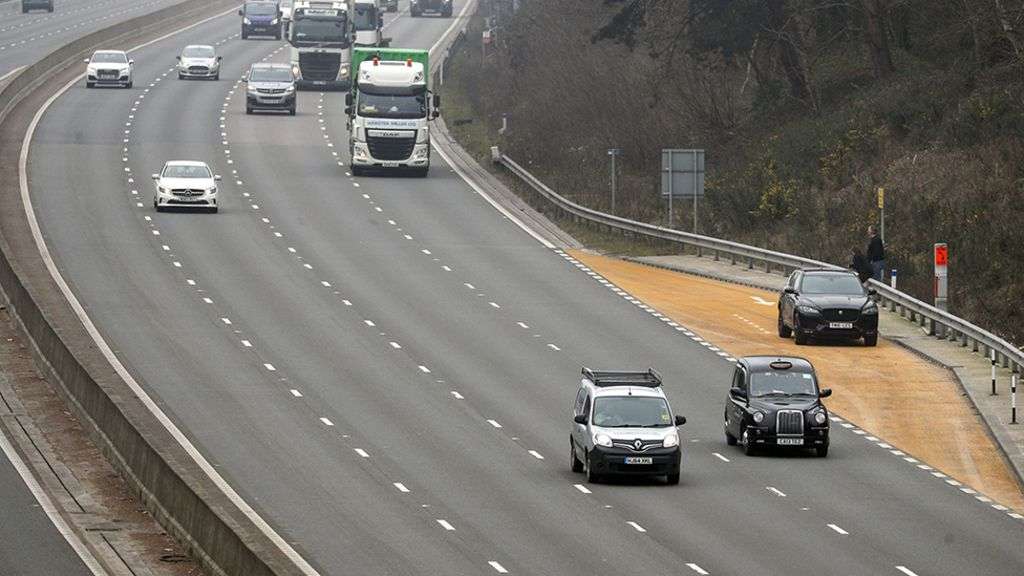The technology behind England's smart motorway network stops working on a regular basis, the OceanNewsUK has discovered. Figures obtained by Panorama have revealed hundreds of incidents when crucial safety equipment was out of action. A traffic officer who works on the network told the programme he no longer considers it safe. National Highways - the agency in charge of smart motorways - denies the claims. Smart motorways are stretches of road where technology is used to try to regulate traffic flow and ease congestion. There are 193 miles of what's called "all-lane-running" motorway - this means the hard shoulder has been permanently removed to provide an extra lane. The hard shoulder is sometimes open to traffic on another 63 miles of smart motorway and there are a further 140 miles of the network where the hard shoulder has been retained.
Radar and cameras are supposed to spot broken-down vehicles, and warning signs are then supposed to close affected lanes.
National Highways says the latest data shows that "smart motorways are our safest roads".
However, the removal of the hard shoulder has led to concerns about the safety of drivers who break down. Cars can be left stranded in a stream of fast-flowing traffic, and emergency vehicles may struggle to get through to an incident.
Last year the government announced that it was halting the roll-out of new smart motorways because of cost and safety concerns.
It is spending £900m on technology to make the existing network safer, but there are no plans to put the hard shoulder back.
Figures released following Freedom of Information requests by Panorama show that between June 2022 and February 2024 there were 397 incidents when smart motorways lost power, making it difficult to detect when a vehicle has broken down. These outages sometimes lasted days:
- For five days in July 2023 there were no signs, signals, camera or radar at junction 18 on the M6
- In September 2023, there were no signs, signals or CCTV for five days at junction 22 of the M62
- In December 2023, there were no signs, signals, sensors or CCTV for three and a half days at junction 6 on the M5
The worst problems were in the latest period covered by the FOI figures. In the six months leading up to February 2024, there were 174 power outages - almost one a day.
The longest outage was at junction 14 on the M4, a stretch of smart motorway that does have a hard shoulder. The sensors and cameras were out for 11 days.
Edmund King, president of the AA, says the outages are dangerous, particularly on smart motorways with no hard shoulder.
"If you haven't got that technology, it's not even a basic motorway because you haven't got the hard shoulder," he says. "It means that you're playing Russian roulette with people's lives."
National Highways says reinstating the hard shoulder would increase congestion and that there are well-rehearsed contingency plans to deal with power outages.
Power cuts are not the only problem.
National Highways' own figures show that in 2022 there were also 2,331 faults on the radar system which is designed to spot stationary vehicles. The average length of the fault was more than five days.
A traffic officer for National Highways who works on smart motorways, but wishes to stay anonymous, has told Panorama he no longer trusts the radar because he has seen it fail too many times.
"Sometimes it's faulty," he says. "Sometimes they're repairing something and they'll turn it off. I don't always know it's off."
National Highways says the radar detects 89% of stopped vehicles - but that means one in 10 are not spotted.
At least 79 people have been killed on smart motorways since they were introduced in 2010. In the past five years, seven coroners have called for them to be made safer.
National Highways' latest figures suggest that if you break down on a smart motorway without a hard shoulder you are three times more likely to be killed or seriously injured than on one with a hard shoulder.
Claire Mercer has been campaigning for the return of the hard shoulder since her husband Jason died on an all-lane-running stretch of the M1 in 2019.
She says she is regularly emailed by worried insiders at National Highways who want her to warn the public about dangerous faults and outages, a situation she describes as "absolutely ridiculous".
As part of its improvement programme, the government promised in 2020 to build more emergency refuges - safety laybys that motorists can use if they are in trouble.
However, although 150 are supposed to be built by next year, only 13 have been completed so far.
National Highways says a further 34 refuges are under construction.
The agency's operational control director Andrew Page-Dove says action was being taken to "close the gap between how drivers feel and what the safety statistics show". As well as more emergency areas, this would include education campaigns, and improving the resilience of technology systems.
"Safety is our highest priority and our motorways are statistically some of the safest in the world," he says.








